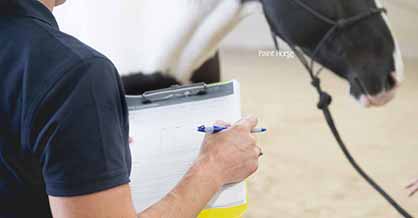What to Expect When You Suspect Ulcers
When it comes to your Paint and his wellbeing, you don’t take any chances. It can be hard to stay calm and keep a level head when your vet says, “We need to do a gastroscopy.” What should you expect when ulcers are suspected? APHA Corporate Partner Merial has the answers:
The first thing to know is that a gastroscopy is the most definitive way to diagnose equine stomach ulcers. While your horse might be showing the tell-tale signs of the condition—such as poor body condition, decreased appetite, chronic colicking or poor performance—the only way to know for sure is by performing a gastroscopy. The quicker you know what you’re dealing with, the faster a treatment plan can be made.
Next, understand what will take place during a gastroscopy; this will help you know what you can and should be doing for your horse. A gastroscopic procedure includes three steps: Pre-Scope, Endoscope and Post-Scope.
The Pre-Scope occurs prior to the actual procedure. Your veterinarian will most likely ask that all feed (including hay, grass and grain) be withheld for 12 hours and all water for four hours. In doing so, the horse’s stomach can be more accurately inspected. The veterinarian will take vital signs during this time and might also sedate your horse so that he remains calm during the evaluation.
Next, the veterinarian will perform the gastroscopy by inserting an endoscope through the horse’s nostril and into his stomach via the esophagus. The endoscope, which is about 11.5 feet long and a half-inch in diameter, allows the veterinarian to view your horse’s stomach and its lining. The endoscope has a tiny light and camera at the end, and the veterinarian controls this with a switchboard. The veterinarian is looking for abnormalities in the stomach lining, such as ulcers, reddened areas, thickened lining, unusual coloring and even parasites that might be causing the horse’s abnormal behavior.
After the gastroscopy, if your veterinarian finds anything abnormal he will recommend the best course of treatment. If ulcers are detected, for instance, your vet might prescribe GastroGard (omeprazole), the only FDA-approved product for equine stomach ulcer treatment. If ulcers aren’t detected but your vet decides ulcer prevention is the best route, he might recommend UlcerGard (omeprazole), the only FDA-approved product to prevent equine stomach ulcers. Both GastroGard and UlcerGard are manufactured by APHA’s Corporate Partner Merial.
For more information on ulcers, treatment and prevention, visit aaep.org. For more information about UlcerGard and GastroGard, visit ulcergard.com.











